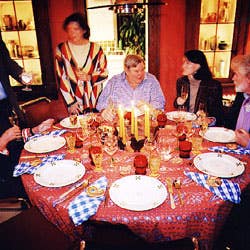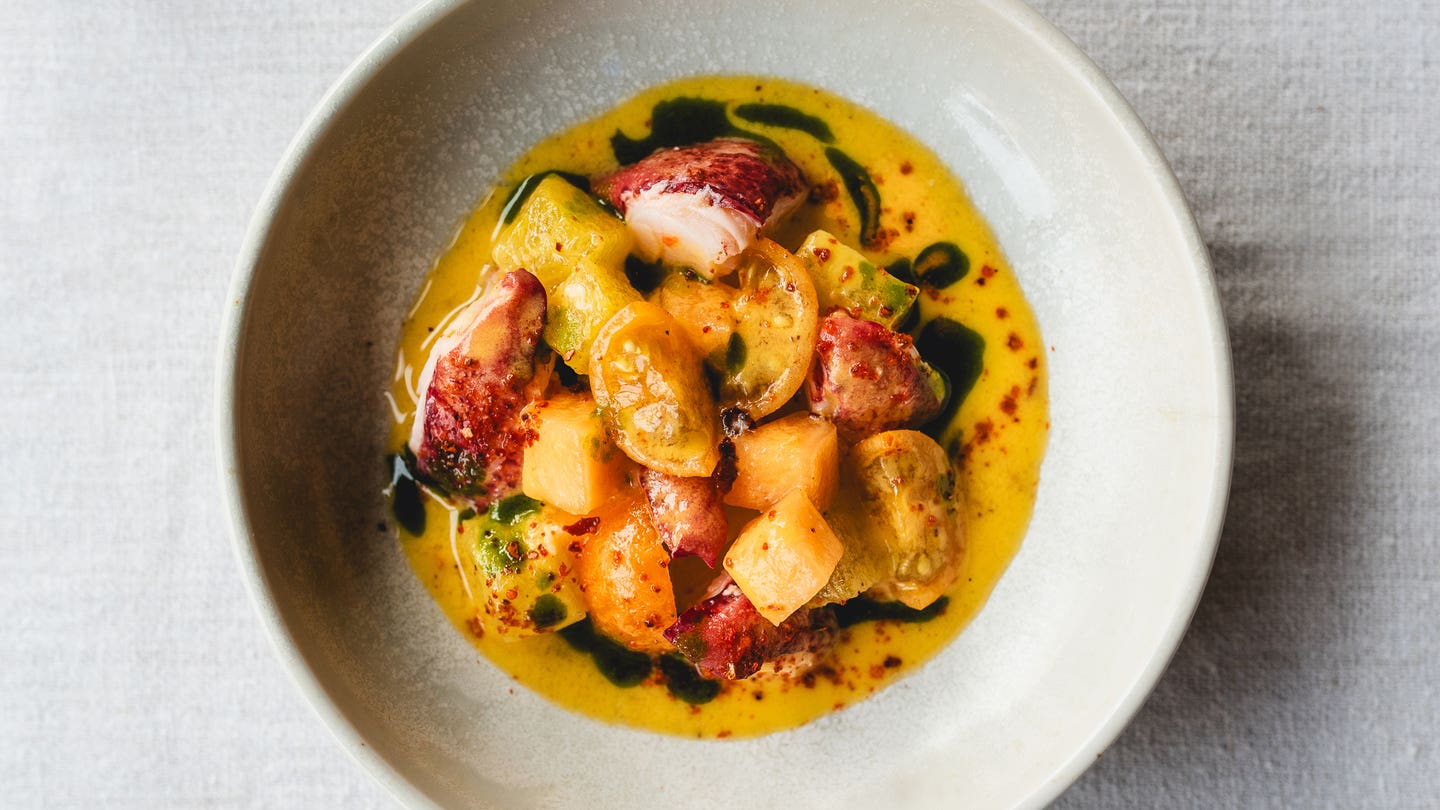
A Pennsylvania Dutch Thanksgiving
When word got around that my wife, Betsey, and I were planning a Pennsylvania Dutch Thanksgiving dinner at our farm in Adams County, Pennsylvania—near Gettysburg, and not far from York and Lancaster counties, where my family first settled in America—the gibes began. Would we serve sausage as a main course? Pretzel ice cream? Well, no, nothing quite so faux-folkloric. Nor did we strain for absolute ethnic authenticity or historical purity. We tried instead to get the spirit of the thing right. We borrowed from friends, and from books by friends, as well as using at least one old family recipe that has been in our holiday repertoire for generations. Like most Thanksgivings, this one was traditional—but modernized a little bit here, crossbred a little bit there.
After a lifetime of wandering the world, it is remarkably restorative to return to one's roots and to the food of one's childhood, produced in loam enriched by generations of husbandry by frugal, industrious Amish and Mennonite farmers. My family is as German-American as sauerkraut, but my parents and my grandparents, members of the generations that fought against the Germans in both world wars, didn't talk about their background. It was not that the older generations denied their origins, exactly; they simply avoided the subject if possible. But their food gave them away—as food always does. Immigrants quickly shed their national costumes, their language, even their Old World names (Apple used to be Apfel), but it takes a lot longer for them to abandon their favorite things to eat.
So we consumed a lot of German-American dishes, especially on holidays. Recipes were handed down, uncorrupted, from mother to daughter (and sometimes son) as the decades slipped by—and my mother always managed to find things like slow-cooked apple butter and the smoky, spicy luncheon meat called Lebanon bologna at local farms or shops. We called these things Pennsylvania Dutch. Our forebears had been among the German and Swiss families that settled in southeastern Pennsylvania in the 18th and 19th centuries, then moved on to southwestern Pennsylvania and to North Carolina, Ohio, Indiana, Iowa, and beyond. Sloppily pronounced, "Pennsylvania Deutsch" (meaning "Pennsylvania German") became "Pennsylvania Dutch".
William Woys Weaver, the ranking authority on the subject, writes in his book Pennsylvania Dutch Country Cooking _(Abbeville Press, 1993) that Pennsylvania Dutch food has _Bodegeschmack—which is what the French call gout de terroir, the taste of the land. It is robust, boldly flavored, down-to-earth cooking. It is also misrepresented and misunderstood. The closest most Americans have come to tasting it is at the roadside industrial feederies in the Amish country around Lancaster, Pennsylvania, where sweet, overstarchy food is served in portions that would choke a sumo wrestler. The real thing is closer to Alsatian cuisine than anything else (and serious eaters know how liberally the Guide Michelin strews stars on the restaurants in and around that French region on the German border). Unfortunately—though they are Feinschmeckers (gourmets) of the first order—the Pennsylvania Dutch have no tradition of first-class restaurants or professional chefs. Theirs remains almost wholly a household cuisine.
The celebration of the Thanksgiving feast begins, for us, with the assembling of raw materials. The year's last sorrel leaves from our garden went into the soup, and our last few tarragon sprigs went into the stuffing. We used a few other products we had grown ourselves, including the native but uncommon smokehouse apples for one of the pies. Most of the rest of the ingredients came from elsewhere in Pennsylvania—and tracking them down was one of the delights of the enterprise. Overorganized as ever, we started well in advance, laying in a supply of John Cope's dried corn, which is such an indispensable part of my family's holiday rhythms that my mother faithfully sent it to me each Thanksgiving during the three years I spent in Vietnam. We shopped around for the relishes that adorn the Pennsylvania Dutch table, ending up with five: bread-and-butter pickles, pickled beets, chowchow, watermelon pickles, and celery ribs—some from Dietrich's Meats and Country Store (an extraordinary farm market in Krumsville), others from Dan Stoltzfus (at the venerable Lancaster Central Market), a gent with a gray spade beard who patiently explained which examples of his art had taken blue ribbons at the most recent Southern Lancaster County Fair in Quarryville.
A couple of days before Thanksgiving, we drove up to the heart of Amish country—a soul-satisfying, late-autumn expedition along rural Pennsylvania back roads. Silos punctuated the landscape like exclamation points. We passed plows pulled by teams of four horses through fields of corn stubble turned golden by the slanting rays of the afternoon sun. We admired a local dairy farm, where Jersey and Holstein cattle grazed against the hazy backdrop of Blue Mountain. Our destination, however, was Eberly Poultry, a third-generation operation that processes chickens, turkeys, geese, ducks, partridge, quail, and more. All the birds are raised in small flocks by Amish and Mennonite farmers living within a 50-mile radius of Bob Eberly's plant, and all are raised "as nature intended," he told me, "with no pesticides, no hormones, no chemical fertilizers, strictly free-range." Old and new meet on Eberly's doorstep near the hamlet of Schoeneck (the name means "beautiful corner" in German); horses, their breath visible in the cold air, prance past the plant along Mt. Airy Road, drawing the boxy black carriages used by the Amish, while semis hurtle along the Pennsylvania Turnpike a mile away.
Eberly's free-range turkeys had won a taste test conducted by the New York Times a couple of days before we got there. The phone was ringing off the hook, and Eberly was fresh out of gobblers. Fortunately, we had decided beforehand that the centerpiece of our meal would be a goose—a fowl more favored in German (and, for that matter, Alsatian) cooking than turkey—and Eberly picked out a perfect, 12-pound embden, freshly slaughtered and (as time would tell) dark and firm of flesh, full-flavored, almost gamy.
The late November weather last year was miserable—cold, gray, with rain trailing off into mist—but that didn't deter our six guests, most of whom traveled fair distances to join us. Catherine, our daughter, who came in from New York, had the flu—but that only prompted learned discussion of the relative merits of champagne and whiskey as cures. The mood was spirited inside our stone farmhouse (an Arts and Crafts-era structure, built in 1914 from plans by Gustave Stickley). Our ebullient Washington neighbor Jurek Martin puffed away at some notably nasty cheroots, oblivious to my demands that he desist, while our friend Robin Hill's boxer, Schepsi, ambled elegantly about with a bandanna knotted around his neck. We all spun stories about absent friends and Thanksgivings past, warmed by a big fire of Georgia fatwood kindling and applewood logs that burned fiercely on the fieldstone hearth. Catherine chattered gamely away between sniffles.
My wife grew up in Richmond, Virginia, where a festive gathering without Smithfield ham in some guise—usually with biscuits—was unthinkable. A close Pennsylvania Dutch equivalent, we had decided, were the ubiquitous local little potato rolls, made from potato flour, so we served thinly sliced Smithfield ham on those, and Betsey plied the crowd with champagne and ham, ham and champagne.
Thanks to the quality of Bob Eberly's fowl and a clever steam-roast method of cooking—which drains the excess fat from the bird while producing a properly crisp skin—devised by Julia Child, the goose was the best I have ever eaten. Our guests, for whom goose probably seemed less ethnically imperative, exclaimed most about other things—notably the sorrel and watercress soup, modified a bit from a recipe in Alice Waters's book, Chez Panisse Vegetables (HarperCollins, 1996), to cope with the shortfall in my late-season sorrel crop. The Pennsylvania Dutch have eaten sorrel since the 18th century—though seldom, I would bet, in a preparation as refined as this. A William Woys Weaver recipe for sauerkraut with ginger, which sounds as unpromising as chicken with licorice, won a lot of votes, as did my mom's sweet and unctuous creamed corn. The stuffing (or dressing, as my family called it, for reasons unknown), made with dried morels, chanterelles, hen of the woods, and beech mushrooms, after a recipe from Pennsylvania-born mushroom specialist Jack Czarnecki, another friend, was also a hit.
And since this was Thanksgiving, the one day of the year when all but card-carrying members of the gastronomic gestapo encourage—or at least forgive—wretched excess, there was even more: red cabbage made in the sweet-and-sour style of Egon Ronay, the Hungarian-born English restaurant critic who first urged me to write about food two decades ago; herbed spatzle, a modern twist on the traditional German (and German-American) drop dumpling; apple pie (for which I peeled and cored the smokehouse apples on a funky old apple lathe); and Pennsylvania Dutch raisin pie—a delicacy sometimes known as funeral pie because it was often taken to grieving families. We served it all on Adams Rose platters and dishes, 19th-century pieces that were made in England to the flowery taste of the Pennsylvania Dutch. For a final local flourish, we served miniature Hershey's chocolate bars with the coffee; Milton Hershey, after all, was an enterprising Pennsylvania Dutchman of Swiss descent—who turned a sweet tooth into a Fortune 500 company.
It all went swimmingly, peerlessly overseen by Betsey in a 1950s rummage-sale apron. We had more food than wine left over, but not much of either. It was still raining the next morning, and we decided to postpone a planned tour of the Gettysburg battlefield and sleep in. The hardy Pennsylvania Dutch of yore would have thought us wimps, I knew, but after that dinner, a slothful morning seemed the better part of valor.
Keep Reading
Continue to Next Story










